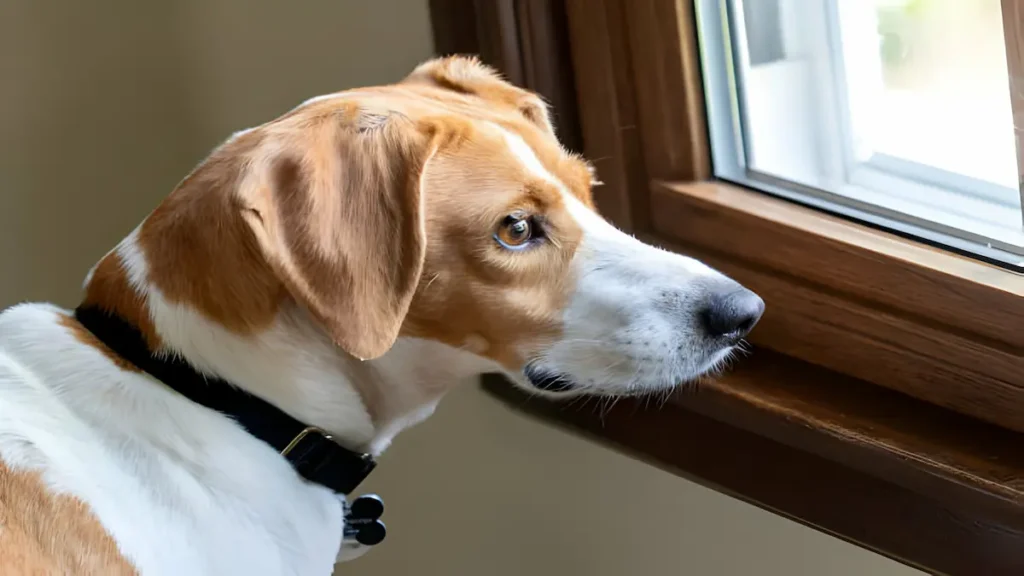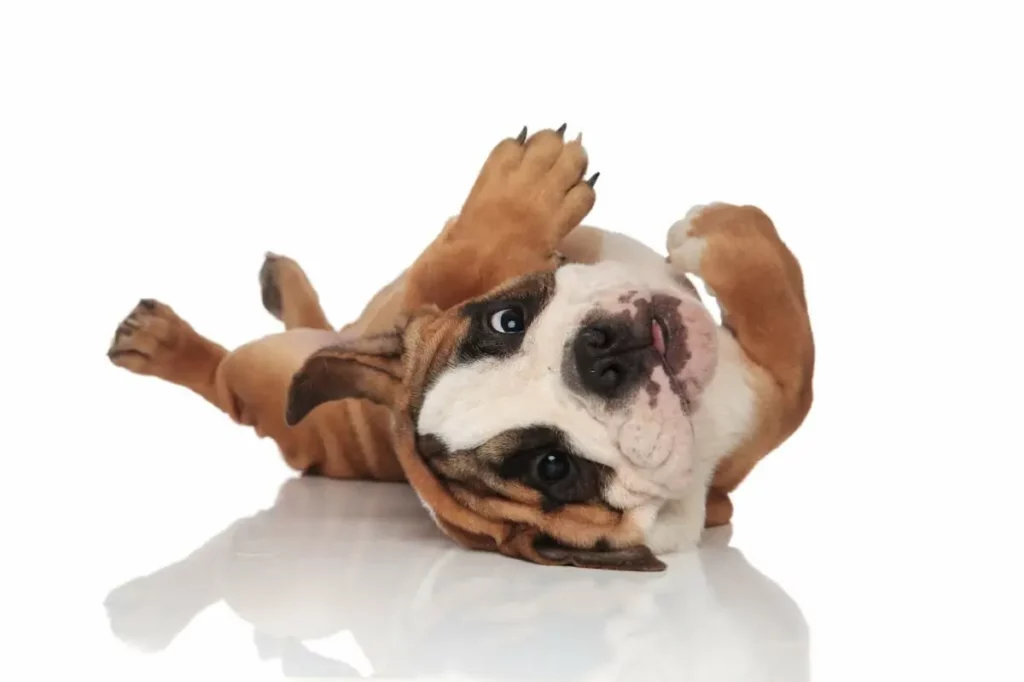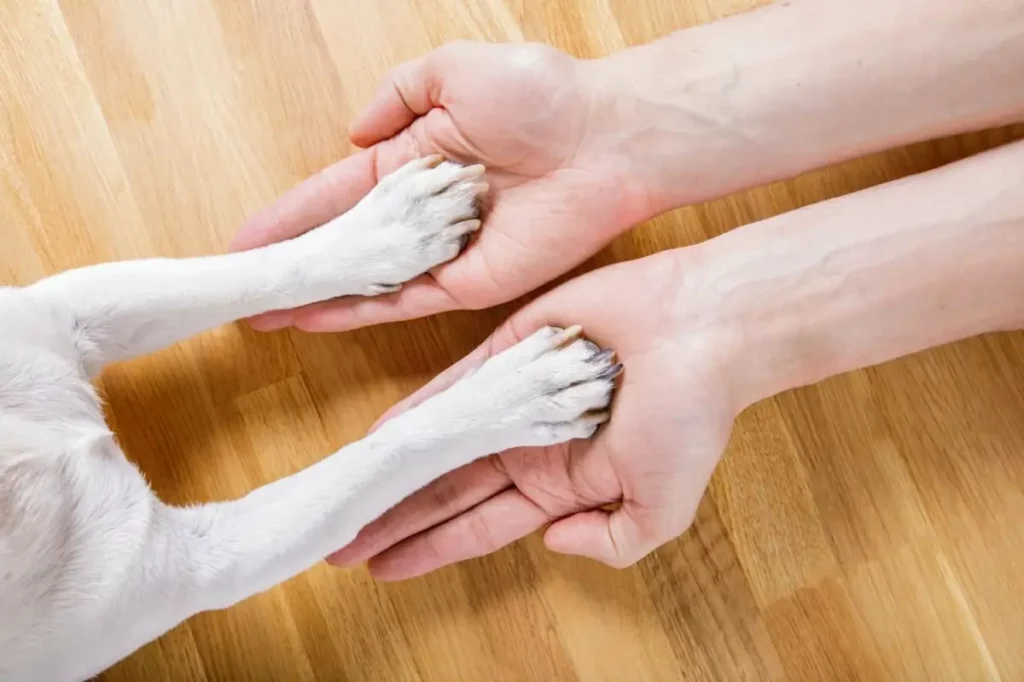Separation anxiety in dogs can be a challenging and heart-wrenching issue for both pets and their owners. It’s essential to understand the signs, causes, and effective strategies to alleviate this distressing condition.
As dog owners, we absolutely love our fur pals. We expect them to love us back just as much, but sometimes we may notice they love us what seems like a bit too much. This can be so much so that it becomes hard for them to leave our side. They become extremely attached and dependent on us, as such, when we leave our house, it always becomes a challenge. This is a strong indication of separation anxiety.
Those suffering from it become distressed when you leave, or prior to leaving your house, and are often super excited like they haven’t seen you for ages when you return. This type of behavior is a serious condition and should be fixed. This article will go over what causes this behavior, signs to look out for, as well as some helpful tips on dealing with separation anxiety.
Medical Disclaimer: The information provided in this article is for informational purposes ONLY, NOT a step-by-step guide nor as a substitute for veterinarian advice. For more details please see our Medical Disclaimer.

What Causes Separation Anxiety In Dogs?
Determining the definitive root of separation anxiety in dogs is still unclear as some dogs with similar experiences do not have it. Every case is unique in its own nature. However, there are several reasons that may have contributed to the development of this disorder. Below is a list of possible factors.
Past Traumatic Experiences: If you adopted your dog who has been neglected or not given any attention, it is easier for them to develop separation anxiety. Being in a shelter or boarding kennel may have the same effect.
Inexperienced Dog Owners: We know how important it is to show our dog the love they earnestly deserve, but some dog parents just go above and beyond. They just love their pooches to bits. Yes, it’s good to know they absolutely cherish their furballs, but at the same time, they’re unknowingly setting their dogs up to have separation anxiety.
Actions such as creating a big scene when they are about to leave the house and/or coming home to immediately kiss their dogs, pamper them, and apologize to them for being away for too long are just a few examples. The dogs will see that departing and returning home is a big event and it’s something they should worry about.
Has Never Been Left Alone: When a dog has never been left alone, he will get anxious, especially when he’s constantly by his owner’s side. Perhaps you got a new dog and it’s your first time leaving him. As a result of not being taught to be left alone, he becomes overly clingy. If you have a pup, the earlier you get rid of separation anxiety, the better. Training tends to be easier when young and becomes harder as the dog ages.
Change In Residence: Moving into a new location can be a stressful time for dogs. They’ve been well acquainted with the old location and moving to a new one makes them feel unsure of the environment. Your home is your fur friend’s safe place. He knows the whereabouts and is comfortable.
When you move to a new location, the scent changes, and the sound is different. All of these things will be picked up by your dog, and as a result of being alone, he will feel insecure. This also goes with moving from an animal shelter to your home, if that’s the case.
Change In Ownership: Similar to the above reason, rehoming a dog is just as stressful to him as moving to a new location. He will feel depressed and will most definitely miss the previous owner if he’s coming from a happy home. If he comes from an abused background, he’ll be mistrusting, fearful, or aggressive when approached.
Change In Routine: A sudden change in routine is one of the main triggers of separation anxiety. For instance, when a family member goes to college, a change in work schedule, a new addition to the family, or the loss of a loved one. Let’s say some owners have been home a lot, perhaps on vacation or working from home, and the routine changes. They went from being with their dogs all day to being gone all day. That’s a drastic change and is often when the problem arises.
Clingy Dog Breeds: No dog breeds are exclusive to develop separation anxiety but there are some that are more prone to it. Those dog breeds tend to be more hearty and bond quickly with humans such as German Shepherds, Labradors, Border Collies, Bichon Frise, Chihuahuas, and so on. While all dogs are social and thrive in groups, some breeds are bred to work alongside humans, hence they are more vulnerable to separation anxiety.
Related: curing dog separation anxiety quickly
How To Tell If My Dog Has Separation Anxiety?
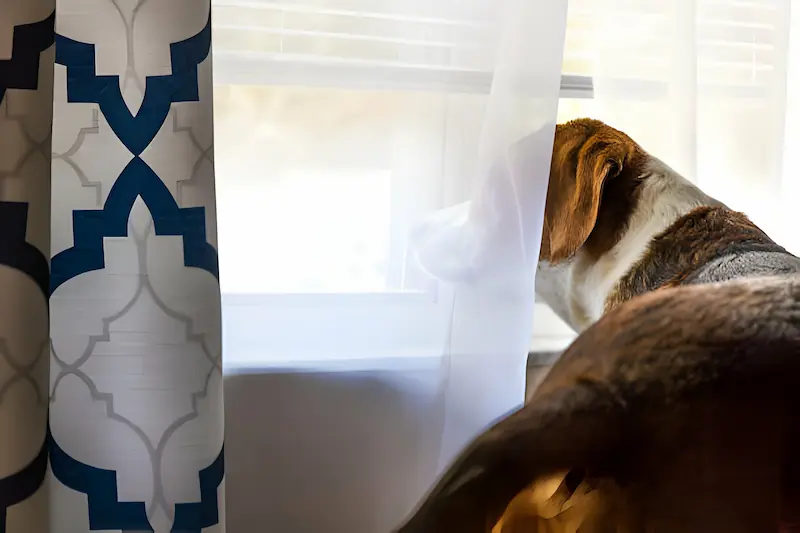
Dogs with separation anxiety will display various abnormal behaviors and it often occurs exclusively when he’s left alone. Certainly, some of these behaviors listed below can be due to other issues such as boredom, house soiling, inadequate training, and medical problems.
That is why separation anxiety can be hard to diagnose, but when multiple signs are present, it most likely has to do with separation anxiety. It is important to rule out any underlying medical concerns. When in doubt, seek veterinary attention and guidance. The following are common symptoms:
Escaping: When left alone, dogs with separation anxiety will try to escape confinement, which typically results in serious injuries such as broken teeth and injured paws. They will try to dig their way out the door or smash their way out the crate.
Barking, Howling, Whining: A dog will bark, howl, and whine for no other reason than being left alone. As you are leaving the house, he uses his vocal communication to persuade you to come back and be with him. Some will even bark and whine continuously for hours at a time. Many parents will end up knowing after complaints from neighbors or through a doggy camera.
Destructive Behavior: A dog suffering from separation anxiety will display destructive behaviors such as chewing and scratching on furniture and other objects around the house. Again, this only happens when you are not in his presence.
Salivating And Panting: When your pooch realizes you are about to leave, he may begin to drool and pant uncontrollably. Alternatively, you may return home to find your dog soaked by his own drool. An agitated dog will also feel an increase in body temperature which results in sweaty paws.
Pacing: Just like how some dogs pace around the exam room when visiting the veterinarian due to being agitated, it is the same when being separated. They feel stress, and when that happens, they’ll walk in a repeated path or chase their tails due to boredom.
Urinating And Defecating: Some dogs will urinate or defecate out of stress. They simply lose control of their bowel or bladder. This is especially true when they have been potty trained. If this happens when you’re in presence, it’s more house-soiling as opposed to the effect of separation anxiety.
Stealing Your Clothes: When you are not home, your dog will seek whatever has your scent, which is why he steals laundry. The unique scent will offer him reassurance and he’ll typically sleep or rest on top until you are back.
Overly Excited Greetings Upon Return: Like mentioned earlier, once you return home, he will greet you like he hasn’t seen you in years. He’s just super relieved after being in so much stress and will jump on you. Though most dog parents experience this on a daily basis, dogs with separation anxiety will have longer, more intense greeting sessions.
Tips On Dealing With Separation Anxiety
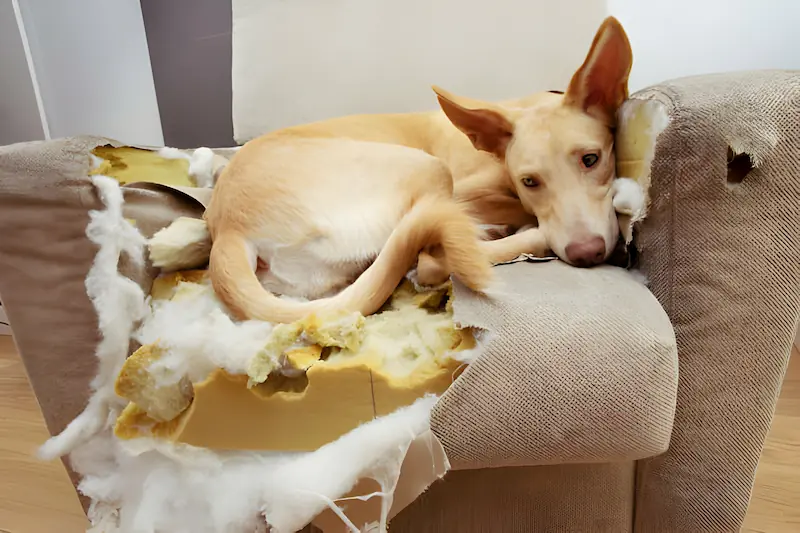
Minimize Coddling: Although well intended, coddling will make your pup associate his whining and barking to you wanting him to do so. He will soon learn that once he whines, you will pamper him and give him the attention he seeks. This would be counterintuitive to preventing or stopping separation anxiety. If you have a pup, starting young will help him grow confident and well-adjusted down the road. If your pooch was adopted, coddling is not a good way to make up for his past experiences. Dogs live in the moment and don’t dwell on the past.
Be Assertive And Don’t Make Such A Fuss: Act as if it is not a big deal when you leave your house. As much as you would like to give him a hug or kiss prior to leaving, this is usually what causes separation anxiety. It makes them even more anxious. Your fur friend views you as the leader so be assertive and calm.
Keep Him Busy When You Leave: Something you should do instead of kissing and hugging is to keep your dog busy when you leave. Introduce a chew toy or a treat stuffed KONG, that way it takes the focus off of you. It will keep him engaged and entertained all while being mentally stimulated. It will also create a positive association instead of being stressed. This process is called counterconditioning in which you convert what your dog thinks is bad into something good.
Take Them For A Walk Prior To Leaving: Walk your dog before you leave. Instead of being anxious about the fact that you left the house, he will be resting instead. He’s going to feel better, both mentally and physically. Although it won’t cure separation anxiety, it takes his attention away from you and reduces stress.
Mental Stimulation: Mental stimulation is just as important as physical stimulation. Playing cognitive games with your pooch not only helps with separation anxiety but also challenges and makes your dog smarter. Playing Hide & Seek or Find The Treats are great nosework games to get him to use his natural scent tracking and sniffing abilities. It’s fun, productive, and rewarding! You are essentially giving your dog the attention he positively adores!
Train Your Dog To Be Independent: When at home, try training your dog to stop following you from room to room. Dogs with moderate to severe separation anxiety find it hard to leave their owners’ side even when they are at home. If that seems to be the case, first train your pooch to be independent by making him stay in one room while you are in another.
To do this, you can teach him commands such as “stay” or “down.” Start off with short lengths of time until your pup gets the hang of it. Then you can gradually increase time and sooner or later you find yourself being able to leave his sight for minutes.
Pretend You Are Leaving: A dog will know when you are about to leave once a routine is developed. Putting on makeup, changing your clothes, picking up keys, putting on shoes, just to name a few, are indicators to your dog that you are about to leave the house. That’s when his separation anxiety starts to kick in.
You don’t want him to link those actions with you leaving. So, what you can do is to display those actions throughout the day to get him to learn that it doesn’t always mean you are leaving. Through patience and time, usually weeks, he will slowly become less anxious because the cues no longer associate your departure from home.
Create A Safe Place: Create a safe and comfortable place for your dog to stay when you leave the house. Add toys and treats to keep him busy. It could be his crate, his cozy bed, or a designated room in the house. Just make sure to teach him that his “safe place” is a joyful and secure place to be through positive reinforcements. Encourage him to stay there and use valuable treats that he wouldn’t normally get to make him more inclined.
Build Up Confidence: When a dog has anxiety, he’s having fear, so building up confidence is key to fixing the issue. Train your dog daily, whether it be simple commands or tricks, will help improve your doggo’s confidence. Make sure to use treats as rewards and not as bribes.
Incorporate Background Music: Playing the right type of music can actually help calm and soothe your fur pal. Some may prefer leaving the radio on while they’re out, but dogs hear at a higher frequency than humans do, so playing music with the right pitches and tones is crucial. It will reduce symptoms of anxiety such as barking and hyperactivity. To make the best out of it, you can try making the music as a safety cue.
Invest In A Pet Camera: Having a pet camera allows you to interact with your dog when you’re not home. Some advanced cameras even allow you to dispense treats on your cue. You can even talk to him and he sure will recognize your voice! They come in handy, especially when you want to monitor your dog’s behavior when left alone. It’s a fun, yet creative way to help reassure Fido and hopefully help with his anxiety.
Don’t punish: Not only is it not effective in treating separation anxiety, but it’ll make it worse as he’s experiencing even more anxiety. Harsh punishments or scolding should not be tolerated even if it’s a completely normal dog. There is no magic cure that can somehow get rid of separation anxiety overnight. Be patient, and keep working on it.
Consult With A Professional Dog Trainer: If none of the tips above are working, it’s time to seek help from the professionals. They have dealt with many dogs with similar behaviors and can form a plan of action to treat the issue.
Conclusion: Separation Anxiety in Dogs
In conclusion, separation anxiety is a challenging but manageable condition. By understanding the signs, addressing contributing factors, and implementing effective strategies, dog owners can provide the support their pets need. Patience, consistency, and love play pivotal roles in helping dogs overcome separation anxiety and lead fulfilling lives.
FAQs: Separation Anxiety in Dogs
Q: Is separation anxiety common in all dog breeds?
A: While it can affect any breed, certain breeds are more prone to separation anxiety. It often depends on factors such as temperament and past experiences.
Q: Can a dog develop separation anxiety suddenly?
A: Yes, certain life changes, such as a move or a change in the owner’s schedule, can trigger separation anxiety even in older dogs.
Q: Are there breeds that are less likely to experience separation anxiety?
A: There is no specific breed immune to separation anxiety. However, dogs with independent temperaments may handle alone time better.
Q: Can I leave my dog alone if it has separation anxiety?
A: Gradual desensitization and training can help manage separation anxiety, but it’s essential to start with short durations and seek professional advice if needed.
Q: Should I adopt another pet to help with my dog’s separation anxiety?
A: While some dogs benefit from having a companion, it’s not a guaranteed solution. Introducing another pet should be done thoughtfully and may require professional guidance.
Q: What is the root cause of separation anxiety in dogs?
Although the unwanted behavior is initially triggered by the owner’s departure, it results from a combination of risk factors that may include elements of the dog’s temperament, the type of relationship it has with the owner, and how the two interact.
dog separation anxiety training
Severe separation anxiety in dogs
Anxious dog training
Did you find this post useful? Save THIS PIN to your Dog board on Pinterest 🙂
how to treat separation anxiety in dogs
how to prevent separation anxiety in dogs
separation anxiety Reddit dog
dog anxiety
my dog barks when I leave
dog poisoning symptoms

